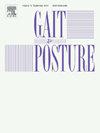Transverse plane kinematics between walking and running change frequently for children and young adults with idiopathic torsional issues
IF 2.2
3区 医学
Q3 NEUROSCIENCES
引用次数: 0
Abstract
Background
Idiopathic excessive femoral or tibial torsion issues are common concerns leading to gait deviations. Instrumented gait analysis can be an important tool for determining lower limb transverse rotations when walking and running. The purpose of this study is to quantify transverse plane changes occurring in children and young adults with idiopathic excessive femoral or tibial torsional concerns when walking versus running.
Methods
A retrospective study of children and young adults with idiopathic femoral or tibial torsional concerns was conducted on walking and running kinematics. A change in rotation of over ten degrees in the transverse plane was considered significant based on control data.
Results
328 participants completed a gait analysis study. 145/328 (44.2 %) displayed a meaningful rotational change in gait (in at least one level of foot, hip or pelvis) when running. For foot progression and hip rotation, participants with an internal femoral or tibial concern displayed an outward change when running. Participants with external femoral or tibial concerns, had a more inward change when running. When measuring pelvic rotation, participants with a change in running showed a more pronounced external change, regardless of diagnosis.
Conclusion
Children and young adults with idiopathic femoral or tibial torsional concerns altered their transverse plane gait angles 44 % of the time, tending to change more often in the opposite direction of their diagnosis. Due to common rotational changes, the collection of running kinematics, in addition to walking, are important for treatment decision making for idiopathic femoral or tibial torsional concerns.
对于患有特发性扭转问题的儿童和年轻人,行走和跑步之间的横向平面运动学经常发生变化
背景:特发性股骨或胫骨过度扭转问题是导致步态偏差的常见问题。仪器步态分析是确定行走和跑步时下肢横向旋转的重要工具。本研究的目的是量化儿童和青年特发性股骨或胫骨过度扭转的横断面变化,当步行和跑步时。方法回顾性研究特发性股骨或胫骨扭转的儿童和青少年的行走和跑步运动学。根据控制数据,在横向平面被认为是显著的上超过十度的旋转变化。328名参与者完成了步态分析研究。145/328(44.2% %)在跑步时表现出有意义的步态旋转变化(至少在脚,髋关节或骨盆的一个水平上)。对于足部进展和髋关节旋转,有股骨或胫骨内部问题的参与者在跑步时表现出向外的变化。有股骨外或胫骨问题的参与者在跑步时有更多向内的变化。当测量骨盆旋转时,无论诊断如何,跑步改变的参与者都表现出更明显的外部变化。结论患有特发性股骨或胫骨扭转问题的儿童和青少年在44. %的时间内改变了他们的横向步态角度,倾向于更多地向诊断的相反方向改变。由于常见的旋转改变,除了行走外,跑步运动学的收集对于特发性股骨或胫骨扭转问题的治疗决策很重要。
本文章由计算机程序翻译,如有差异,请以英文原文为准。
求助全文
约1分钟内获得全文
求助全文
来源期刊

Gait & posture
医学-神经科学
CiteScore
4.70
自引率
12.50%
发文量
616
审稿时长
6 months
期刊介绍:
Gait & Posture is a vehicle for the publication of up-to-date basic and clinical research on all aspects of locomotion and balance.
The topics covered include: Techniques for the measurement of gait and posture, and the standardization of results presentation; Studies of normal and pathological gait; Treatment of gait and postural abnormalities; Biomechanical and theoretical approaches to gait and posture; Mathematical models of joint and muscle mechanics; Neurological and musculoskeletal function in gait and posture; The evolution of upright posture and bipedal locomotion; Adaptations of carrying loads, walking on uneven surfaces, climbing stairs etc; spinal biomechanics only if they are directly related to gait and/or posture and are of general interest to our readers; The effect of aging and development on gait and posture; Psychological and cultural aspects of gait; Patient education.
 求助内容:
求助内容: 应助结果提醒方式:
应助结果提醒方式:


